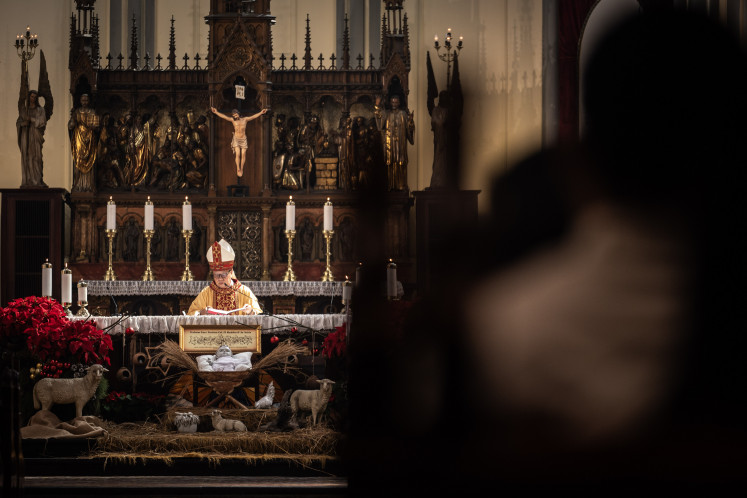Popular Reads
Top Results
Can't find what you're looking for?
View all search resultsPopular Reads
Top Results
Can't find what you're looking for?
View all search resultsSardono's Retrospective at Colomadu sugar mill
Solemn: Dancers perform their routines for Sardonoâs Retrospective â Fabriek Fikr at the former Colomadu sugar mill in Karanganyar, Central Java
Change text size
Gift Premium Articles
to Anyone
S
span class="caption">Solemn: Dancers perform their routines for Sardono's Retrospective ' Fabriek Fikr at the former Colomadu sugar mill in Karanganyar, Central Java.
The Sardono retrospective Fabriek Fikr, showcasing the work of dance maestro Sardono W. Kusumo, ran for three days in late November at the former Colomadu sugar mill in Surakarta, and will be shown at the Singapore International Festival of Art (SIFA) in 2016.
Dozens of dance and theater artists from various cities including 30 dancers from Papua appeared at the former sugar factory in Surakarta, which was built during the reign of Mangkunegara IV in 1861.
Stage actor Tony Broer began the show by climbing the brittle and rusty columns of the mill without safety ropes, moving with agility along the upper iron frame until he was right under the factory roof.
The bare-breasted actor, who was smeared with mud, continued walking around the upper section at a height of over 20 meters. On one of the frames, Tony stood above some long white drapes hanging underneath him. Then he picked up some bottles with colorful paint near to him and poured it on the white cloth.
Tony again moved to find a way down. Spectators had just turned their attention to the around 30 Papuans emerging dancing between the factory machines when Tony suprised the crowd by suddenly joining the dancers.
The dancers' moves seemingly depicted factory employees hard at work. Several dancers wearing koteka (gourd sheaths) were dancing above grinders. Some women moved expressively while other artists strolled along with Papuan musical instruments, acting as foremen. With intermittent yells, their number eventually moved into the realm of modern hip-hop.
Although it was labeled Sardono's Retrospective, only some of the choreographer's work was staged, such as when the maestro made a brief response to the performance of artist Arini Kumara in one of the spaces of the factory.
Sardono in his sweater suddenly came into view, emerging from a crowd of spectators. While he danced, some people brought a costume and helped to dress him. Sardono's suprising move was welcomed with the Papuan dancers' typical yells.
As Sardono only danced for a few minutes, many of the audience members missed his appearance. Another of Sardono's works that was displayed was an 40-hour long film produced together with Faozan Rizal over the course of eight years. It also showcased a number of his paintings referred to as big decorations.
Night fair: Dancers perform the Cembengan Dance during the pasar cembengan night fair on the grounds of the former sugar mill.
Other spaces of the factory also served as open stages to accommodate different artists' works. They included a poetry reading by senior literary figure Sapardi Djoko Damono, who recited his verses on the afternoon of Nov. 21.
'Mas Don [Sardono] is capable of fashioning a show that reflects his experience with regard to spaces in this building. The works are interesting because of the dialectics and questions involved,' said Surakarta choreographer Bambang Besur.
Theater artist Jarot B. Darsono praised the freedom of artistic expression in the retrospective's use of interesting sets. 'They're dancing between old machines and iron frames. I think it requires incredible energy to do so,' said Jarot.
According to Sardono, the sugar mill isn't a mere physical factory but rather a milestone of the early industrial revolution when the majority of Javanese society, who were farmers at the time, became mill workers. The factory also gave rise to the creative industries through the pasar cembengan, a sugarcane milling ceremony with a night fair.
'The cembengan night fair was the start of the grassroots creative industry. That's why we called this event Fabriek Fikr,' said Sardono.
Dances, music and an industrial handicrafts display enlivened the ex-sugar mill complex for three days from afternoon until night.
The Colomadu mill ceased production in 1997. Set up by Mangkunegara IV, the factory became an icon of the economic transformation from agriculture to industry. The Mangkunegara Archduchy Palace had two sugar mills in the heyday of the sugar business in the 1870s; Colomadu in the west and Tasikmadu in the east.
For generations, the Mangkunegara dynasty maintained their successful sugar industry until it ceased operations in 1997 due to the shrinking sugarcane plantations.
Dynamic moves: Papuan dancers bring out their performances among pieces of machinery in the former sugar mill.
' Photos by Ganug Nugroho Adi













